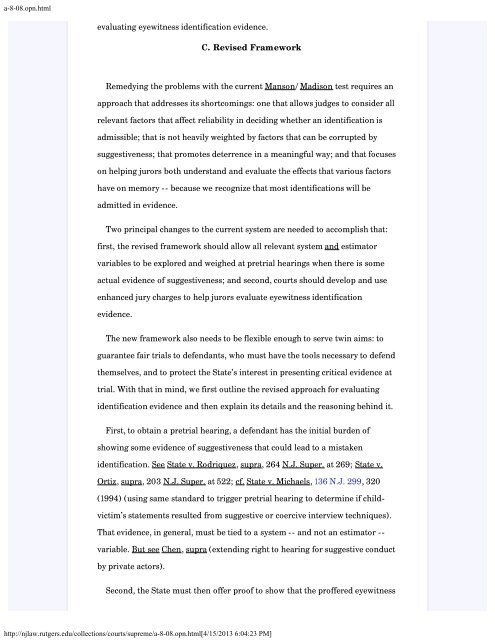State v. Henderson and the New Model Jury Charges - New Jersey ...
State v. Henderson and the New Model Jury Charges - New Jersey ...
State v. Henderson and the New Model Jury Charges - New Jersey ...
Create successful ePaper yourself
Turn your PDF publications into a flip-book with our unique Google optimized e-Paper software.
a-8-08.opn.html<br />
evaluating eyewitness identification evidence.<br />
C. Revised Framework<br />
Remedying <strong>the</strong> problems with <strong>the</strong> current Manson/Madison test requires an<br />
approach that addresses its shortcomings: one that allows judges to consider all<br />
relevant factors that affect reliability in deciding whe<strong>the</strong>r an identification is<br />
admissible; that is not heavily weighted by factors that can be corrupted by<br />
suggestiveness; that promotes deterrence in a meaningful way; <strong>and</strong> that focuses<br />
on helping jurors both underst<strong>and</strong> <strong>and</strong> evaluate <strong>the</strong> effects that various factors<br />
have on memory -- because we recognize that most identifications will be<br />
admitted in evidence.<br />
Two principal changes to <strong>the</strong> current system are needed to accomplish that:<br />
first, <strong>the</strong> revised framework should allow all relevant system <strong>and</strong> estimator<br />
variables to be explored <strong>and</strong> weighed at pretrial hearings when <strong>the</strong>re is some<br />
actual evidence of suggestiveness; <strong>and</strong> second, courts should develop <strong>and</strong> use<br />
enhanced jury charges to help jurors evaluate eyewitness identification<br />
evidence.<br />
The new framework also needs to be flexible enough to serve twin aims: to<br />
guarantee fair trials to defendants, who must have <strong>the</strong> tools necessary to defend<br />
<strong>the</strong>mselves, <strong>and</strong> to protect <strong>the</strong> <strong>State</strong>’s interest in presenting critical evidence at<br />
trial. With that in mind, we first outline <strong>the</strong> revised approach for evaluating<br />
identification evidence <strong>and</strong> <strong>the</strong>n explain its details <strong>and</strong> <strong>the</strong> reasoning behind it.<br />
First, to obtain a pretrial hearing, a defendant has <strong>the</strong> initial burden of<br />
showing some evidence of suggestiveness that could lead to a mistaken<br />
identification. See <strong>State</strong> v. Rodriquez, supra, 264 N.J. Super. at 269; <strong>State</strong> v.<br />
Ortiz, supra, 203 N.J. Super. at 522; cf. <strong>State</strong> v. Michaels, 136 N.J. 299, 320<br />
(1994) (using same st<strong>and</strong>ard to trigger pretrial hearing to determine if childvictim’s<br />
statements resulted from suggestive or coercive interview techniques).<br />
That evidence, in general, must be tied to a system -- <strong>and</strong> not an estimator --<br />
variable. But see Chen, supra (extending right to hearing for suggestive conduct<br />
by private actors).<br />
Second, <strong>the</strong> <strong>State</strong> must <strong>the</strong>n offer proof to show that <strong>the</strong> proffered eyewitness<br />
http://njlaw.rutgers.edu/collections/courts/supreme/a-8-08.opn.html[4/15/2013 6:04:23 PM]
















